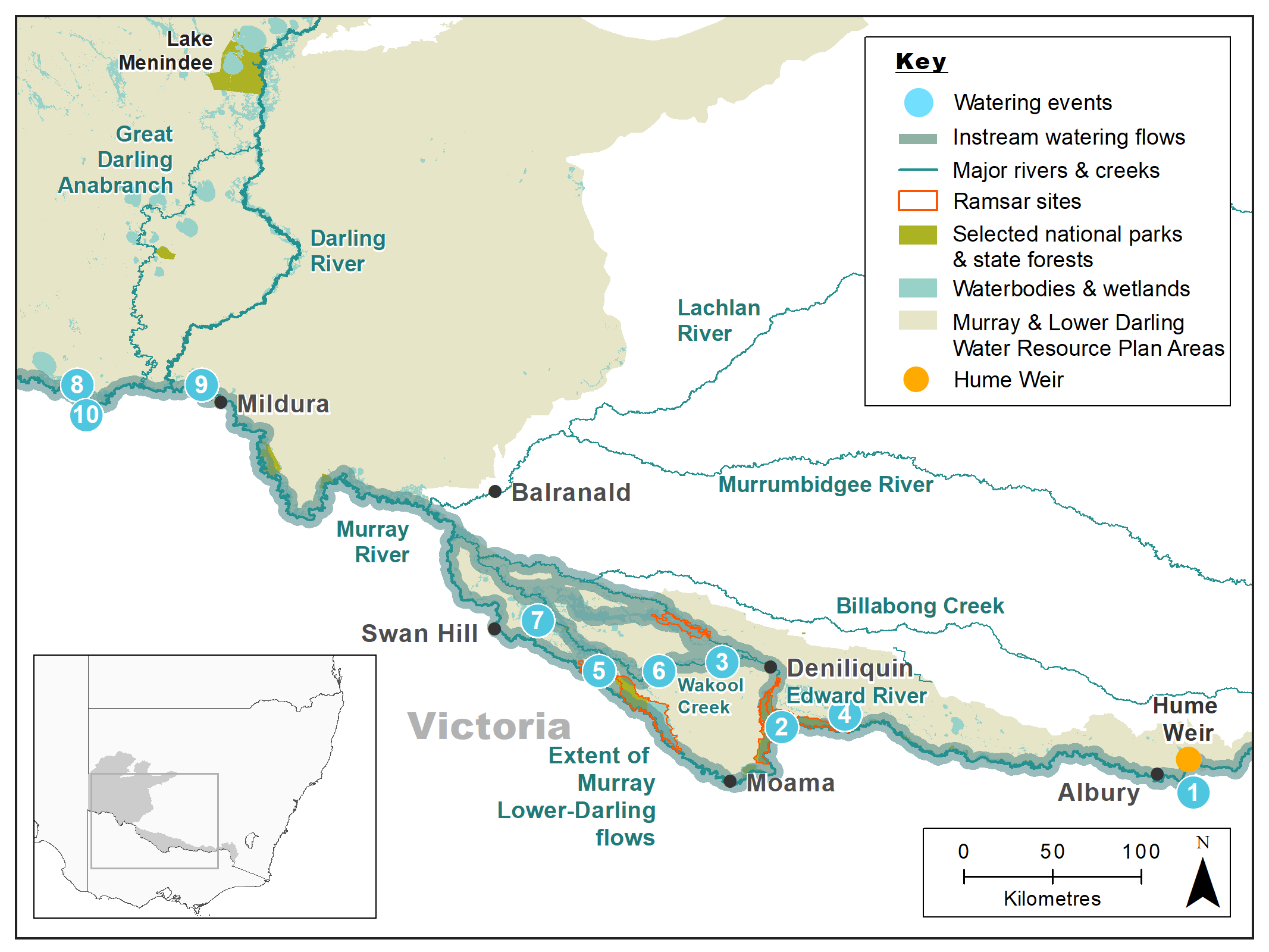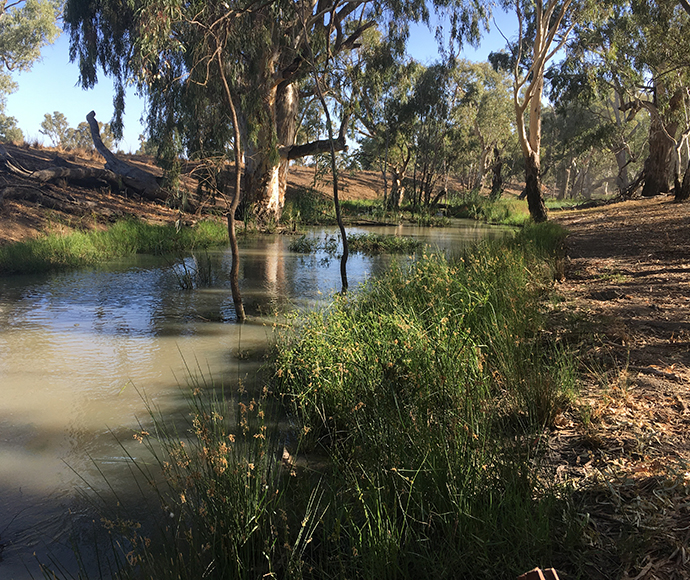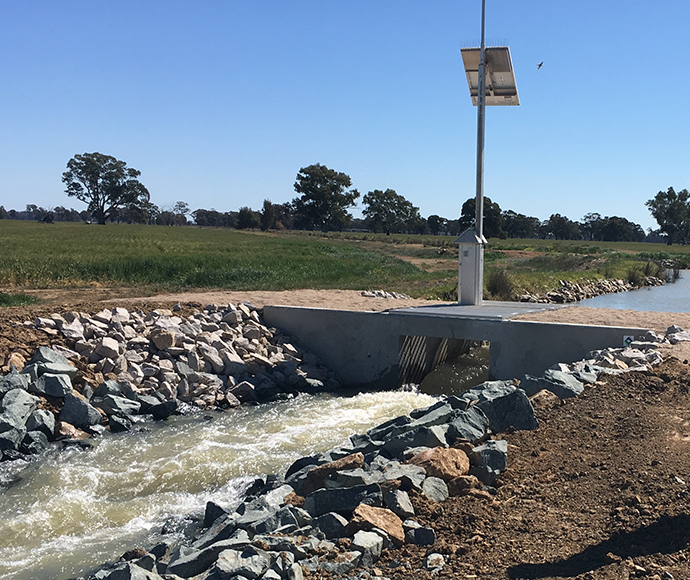Despite extremely dry conditions in the Murray and Lower Darling catchments in 2018–19, managed watering events resulted in significant ecological outcomes for native fish, habitat condition and system productivity.
In the Murray catchment, 142.7 gigalitres of water for the environment across 10 events targeted waterways, floodplains and multiple private property wetlands.
Co-ordinated flows involving water managers from New South Wales, Victoria and South Australia, the Murray–Darling Basin Authority and the Commonwealth Environmental Water Holder successfully connected the river system and floodplain wetlands on a landscape scale. These carefully managed events:
- triggered breeding and movement of native fish
- provided a boost in river and floodplain productivity to underpin the aquatic food web
- supported a myriad of wetland plants that provide important habitat instream and across the surrounding floodplains.
The threatened Southern bell frog was the focus of water delivered into 11 private wetlands during spring using the Murray Irrigation system and private pumping. Southern bell frogs were recorded at all targeted sites and juveniles observed at several locations indicated successful breeding.
Water was also delivered into the Thule Creek (near Barham) for the first time. Water was delivered in partnership with Murray Irrigation and supported by Thule Creek landholders.
Our Water for the Environment Program funded the upgrade of several significant water delivery points in the central Murray and installation of a brand-new structure to increase the volume of water that can be delivered and the amount of habitat available to native wildlife.

Map of the Murray catchment showing waterways, wetlands and locations of water for the environment deliveries made in 2018–19.
Watering aims
After a moderately dry year in 2017–18, dry conditions were forecast for 2018–19. Water managers:
- identified priority actions for the year ahead to build on the gains of the previous 12 months
- prepared to use a portion of the available water to target system-wide outcomes while retaining some in reserve for future years.
The Department of Planning, Industry and Environment – Environment, Energy and Science’s (DPIE–EES) Water for the Environment Team represented the NSW Government on the Southern Connected Basin Environmental Water Committee to deliver water strategically throughout the river system and provide for the year-round needs of native plants and animals. With advice from the Murray Lower Darling Environmental Water Advisory Group, we also delivered NSW Adaptive Environmental Water and the Murray Additional Allowance to several sites across the New South Wales Murray River catchment. These watering events aimed to:
- connect the floodplain wetlands with the river, providing opportunities for native fish to feed, breed and move
- release essential nutrients from the floodplain floor to boost the aquatic food web
- encourage the ongoing recovery of wetland plants to provide habitat, feeding and breeding opportunities for wetland-dependent fauna
- provide foraging opportunities for waterbirds
- replenish wetland refuges in anticipation of dry times in the future.
Water delivery
This table provides a summary of water for the environment delivered in the Murray-Lower Darling catchment during the 2018–19 watering year. Volumes are indicative only.
| Event number | Location | Start date | Finish date | NSW | CEW | EWA | RMIF | MDWWG | Total |
|---|---|---|---|---|---|---|---|---|---|
| 1 | Murray River–Hume Dam to South Australia | 6 Jul 2018 | 30 Jun 2019 | 4258 | 24,975 | 5690 | 43,295 | – | 78,218 |
| 2 | Murray Valley Regional Park via Millewa Regulators | 16 Jul 2018 | 3 Jan 2019 | – | 7505 | – | 11,885 | – | 19,390 |
| 3 | Edward-Wakool: native fish flow | 21 Aug 2018 | 30 Jun 2019 | 33,308 | 33,308 | ||||
| 4 | Tuppal Creek: support native fish | 17 Sep 2018 | 30 Apr 2019 | 2870 | 2870 | – | – | 5740 | |
| 5 | Pollack Swamp: support waterbird breeding | 8 Oct 2018 | 25 Jan 2019 | – | 2000 | – | – | – | 2000 |
| 6 | Murray Irrigation Area: waterbird breeding | 8 Oct 2018 | 30 Apr 2019 | 1522 | – | – | 1522 | ||
| 7 | Mid-Murray private pumping: waterbird breeding | 8 Oct 2018 | 30 Apr 2019 | 1070 | – | – | – | – | 1070 |
| 8 | Lower Murray: southern bell frog | 21 Nov 2018 | 30 May 2019 | 836 | – | – | – | 836 | |
| 9 | Fletchers creek: support waterbird breeding | 14 Apr 2019 | 31 May 2019 | 115 | – | – | – | – | 115 |
| 10 | Wingillie wetland complex: threatened fish | 26 Jun 2019 | 26 Jun 2019 | – | 59 | – | – | 458 | 517 |
| Region | Total |
|---|---|
| NSW | 10,671 |
| CEW | 70,717 |
| EWA | 5,690 |
| RMIF | 55,180 |
| MDWWG | 458 |
| Total | 142,716 |
Notes: Location numbers in the table relate to watering events marked on the map.
NSW = NSW adaptive environmental water; CEW = Commonwealth licensed environmental water; EWA = Environmental water allowance (Murray Additional Allowance) accrued under the Water Sharing Plan for the NSW Murray and Lower Darling Regulated Rivers Water Sources 2016; RMIF = River Murray Increased Flows; MDWWG = Murray–Darling Wetlands Working Group.
Outcomes
We worked with the Commonwealth Environment Water Holder (CEWH) and partner agencies to manage a delivery of water that connected the Murray River from Hume Dam to the Lower Lakes in South Australia.
We also partnered with the CEWH to achieve a range of environmental outcomes in the Edward–Wakool river system. These events:
- connected the river and floodplain
- increased access to habitat for native fish
- encouraged breeding and movement of native fish
- maintained in-stream, wetland and floodplain forest vegetation condition.
We also partnered with Murray Irrigation and local landholders to deliver water into private wetlands in the central- and lower-Murray to support the endangered southern bell frog. These events were also supported by the NSW Government’s Saving Our Species Program.
Our program also delivered water into the Thule and Tuppal creeks in partnership with Murray Irrigation, with the support of the local farming communities.
Case study: Upgrade to Thule and Tuppal creek escapes
Water was delivered into the Tuppal and Thule creeks in 2018–19 before work began on infrastructure to enhance future environmental outcomes.
A test event in Thule Creek was conducted to gather information on flow progression, the extent of inundation while also improving water quality and habitat health for native fish and turtles. A total of 550 megalitres of adaptive environmental water (AEW) was delivered, with support from adjoining landholders and the Murray–Lower Darling Environmental Water Advisory Group (EWAG).
Following the test flow, we provided $183,000 to upgrade the Thule Creek escape, which releases water from the Murray Irrigation Limited system into Thule Creek. The upgrade increases the capacity of the escape from 30 megalitres per day to 130 megalitres per day. This will enable more water to be released into the creek during future watering events and will help reconnect it with the Wakool River.
In Tuppal Creek, water managers delivered 5740 megalitres of AEW to improve water quality and connect the creek with the Edward River. Again, the event was endorsed by adjoining landholders and the Murray–Lower Darling EWAG.
We then funded the upgrade of 2 escapes and the installation of new infrastructure to increase the volume of water that can be delivered into the Tuppal Creek in future events. The $1.3 million project was partly funded through the NSW Government’s drought relief fund.
These projects were initiated by landholders keen to see the health of their local creeks improve and local contractors carried out the works.
The Tuppal and Thule creeks provide ideal nursery and refuge habitat for a range of native animals, including native fish.
As well as water quality improvements, local towns are expected to see the flow-on benefits through improved recreational fishing opportunities and tourism.

